
In this article
Attics are excellent nesting locations for many types of pests. They’re warm, unfrequented by humans, and safe from natural predators. Therefore, homeowners often find rodents in attics.It can be hard to detect a rodent infestation in your attic if you don’t frequent it often. And since rodents can be quite small, the noises they make will be minimal and hard to detect.
- Common Rodents in Attics: Squirrels, rats, and mice are the most frequent attic invaders, entering through small gaps and chewing through materials to gain access.
- Risks of Infestation: Rodents gnaw on structural elements, wires, and insulation, leading to fire hazards, energy inefficiency, and potential disease transmission, including Hantavirus and Lyme disease.
- Rodent Removal & Prevention: Effective control methods include trapping, exclusion, and sealing entry points. Preventative measures like trimming tree branches, installing vent guards, and sealing holes reduce infestation risks.
- Critter Control’s Professional Services: Unlike extermination-only services, Critter Control provides long-term solutions, including rodent removal, attic decontamination, and insulation restoration to prevent future infestations.
One of the most popular places in your home for different types of animals to live is your attic. The most common attic pests are raccoons, bats, rats, mice, squirrels, opossums, and birds. Attics are excellent nesting locations for many types of pests. They’re warm, unfrequented by humans, and safe from natural predators. Therefore, homeowners often find rodents in attics.It can be hard to detect a rodent infestation in your attic if you don’t frequent it often. And since rodents can be quite small, the noises they make will be minimal and hard to detect.
The Most Common Rodents in the Attic
- Norway Rat
- Roof Rat
- House Mouse
- Grey Squirrel
Squirrels, mice, and rats are the most common rodents that live in attics. The Norway rat and the roof rat are the most common rats. The Eastern Gray Squirrel is the most common squirrel species. The house mouse is the most common rodent.
Table of Contents
Rodent Removal from the Attic
The type of rodent infestation you have will determine the type of rodent traps to use.
Cage Traps or One-way Doors
One-way doors and live traps are the most effective ways to get rid of squirrels.
Rodent Traps
Rats and mice reproduce at an astounding rate. Rat trapping and mice trapping take between five to fourteen days. Rats can reproduce up to 14 times per year with around seven offspring per litter. That means that a single female rat could produce nearly 100 babies within a single year.
Exclusions
Some rodents can fit through openings as small as 15mm in diameter, which means that small holes, gaps in doorways, and wall vents often serve as common entry points. If a rodent cannot find a large enough entry point, it can gnaw through materials like shingles and plywood to gain access to your attic.
Signs of Rodent Infestation in Attic
Attics are excellent nesting locations for many types of pests. They’re warm, unfrequented by humans, and safe from natural predators. Therefore, homeowners often find rodents in attics.It can be hard to detect a rodent infestation in your attic if you don’t frequent it often. And since rodents can be quite small, the noises they make will be minimal and hard to detect.
Typical Signs of Rodent Infestation
- Squeaking noises
- Scurrying Sounds
- Gnawing Sounds
- Gnawing on wood, pipes, electrical wires
- Nests in insulation
- Droppings and urine
Pictures of Rodent Activity in Attic
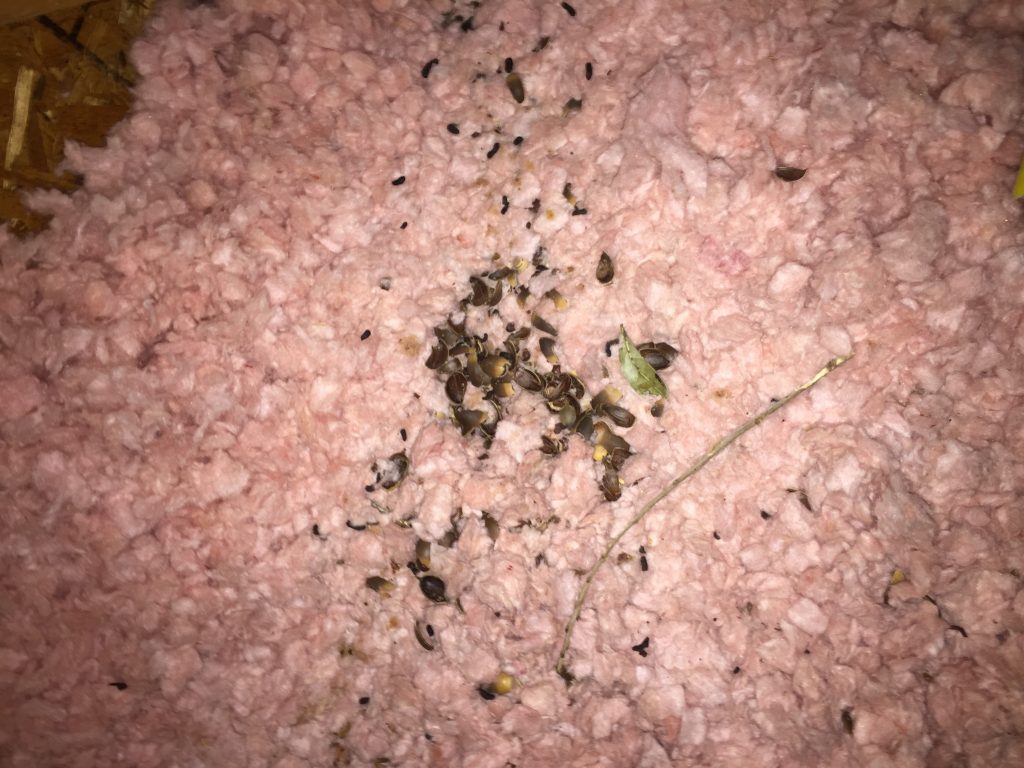

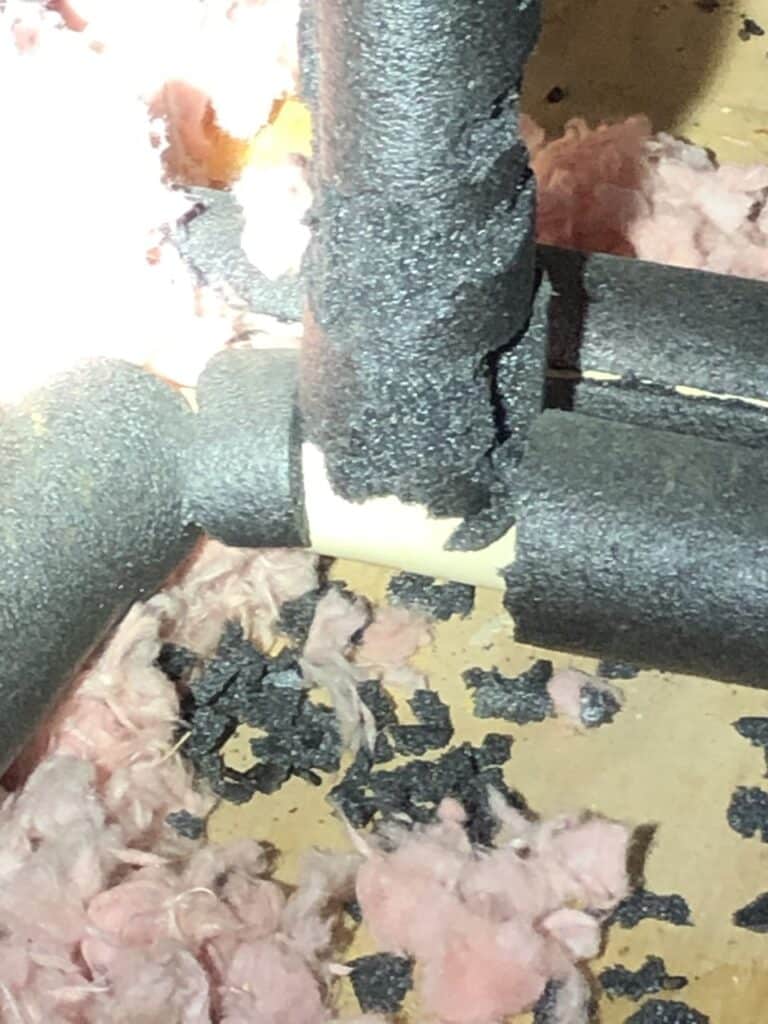
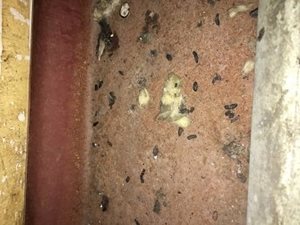
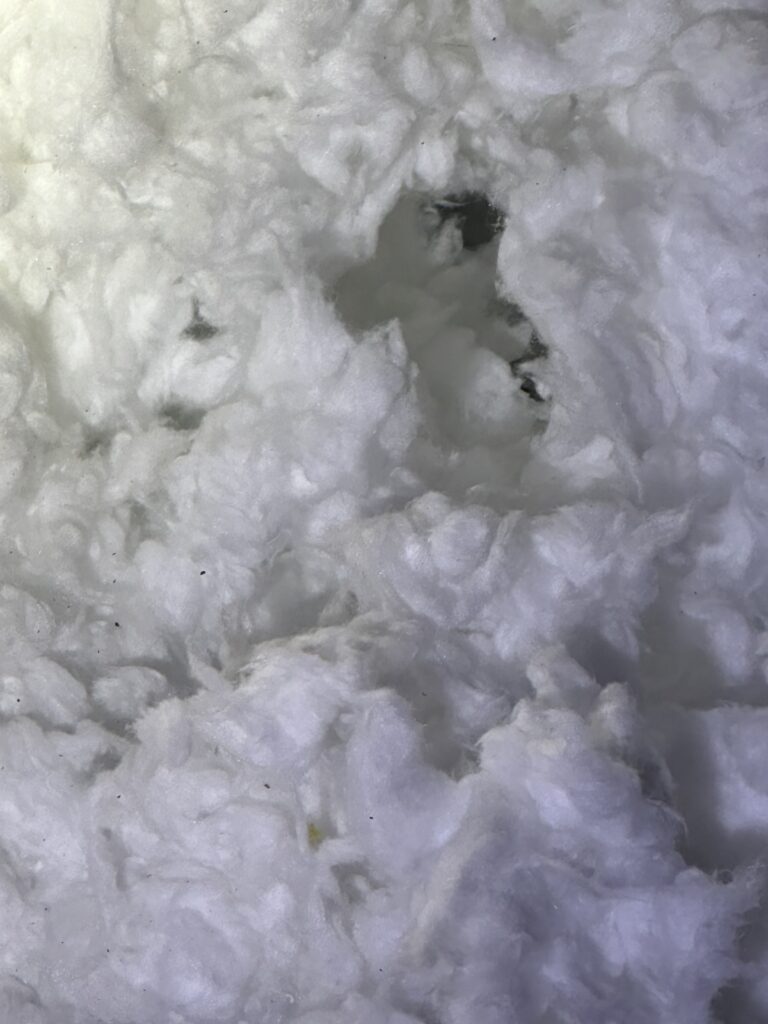
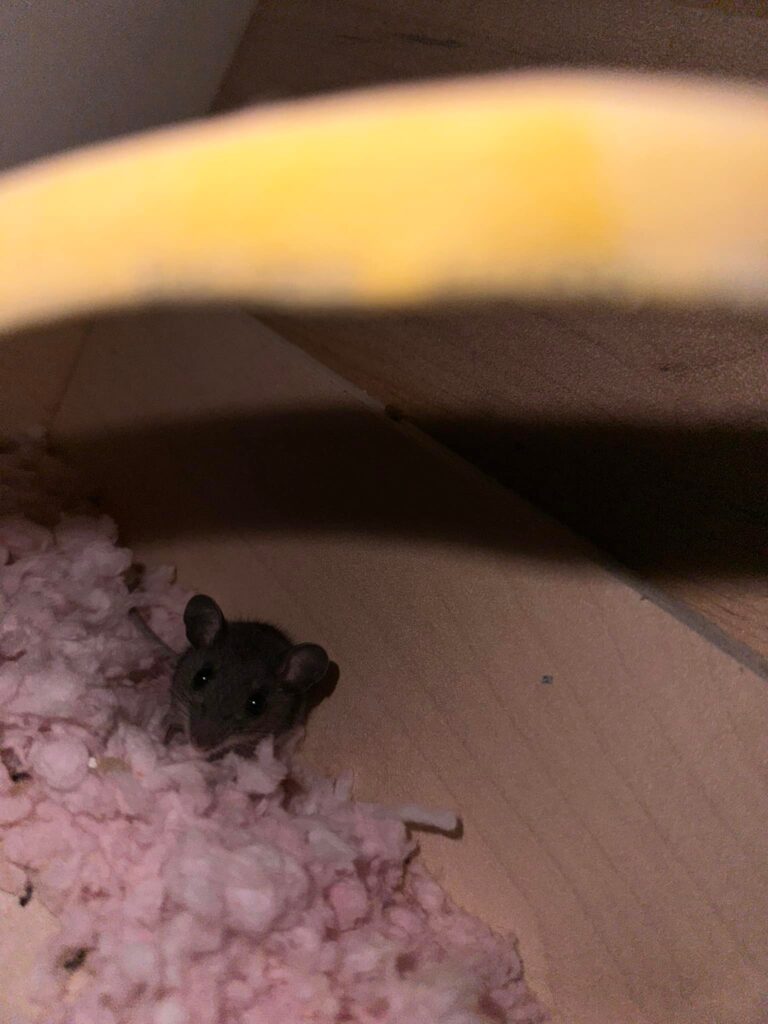
Dangers of a Rodent Infestation in Attic
Though they’re all different pests, rodents in the attic cause similar issues. The defining feature of rodents is the constant gnawing. To keep their teeth at a practical length, mice, rats, and squirrels all have to gnaw constantly. This leads them to damage support beams, stored items, HVAC, and wires. Frayed electrical wiring can cause shorts or even fires.
Additionally, having any rodents in the attic comes with health risks. All three of the common offenders carry parasites in their fur. These pests easily move around homes and contribute to the spread of Lyme disease. Rats and mice also transmit Hantavirus, plague, and salmonellosis. Though the risk is low, squirrels are capable of spreading rabies.
Rodent Control in Your Attic
There are a few ways to rodent-proof your attic, and most of them start before the rodents reach the attic.
Rats are also proficient swimmers, capable of traveling through sewer lines and entering buildings by emerging from toilets and open drains.
Check your roof and soffits for any small holes. Any rodent can take a pre-existing hole and gnaw it to make it bigger. Sealing up any kind of hole will cut the chances of a rodent invasion down.
Another way rodents can get into your home is through your vents. There are a few ways you can keep rodents out of your vents:
- Place traps near the entrances of vents. This can work well if rodents have already gained access to your vents.
- Protect your vent with stainless steel mesh. This will prevent the rodents from getting into your vents. Cloth works well with bugs, but rodents can chew through it.
- Install a vent guard on your roof. Caging the area around the vents on your roof will keep any curious critters away from your outside vents.
Even if you successfully remove every rat in your home, other rats will likely return to the same comfortable spot. Unlike some pest control services that only exterminate rodents, Critter Control prevents future rodent infestations. It is essential to seal all entry points of a quarter-inch or larger.
Why Attic Remediation Is Important
Rodents in attics are a serious problem and often leave major damage behind in their wake. After ridding your attic of their presence, it’s important to complete proper attic remediation because of the potential:
- Health risks: Rodents carry various disease-inducing organisms, such as hantavirus, leptospirosis, and salmonella, which can be transmitted through their droppings to your pets and loved ones. Additionally, their feces and urine can cause respiratory ailments and allergies for you and your family.
- Structural damage: To gain entry to your attic and build cozy nests for their young, rodents will chew on wood, wiring, and insulation. They’ll gnaw through nearly anything in their way, causing fire hazards and compromising the structure of your attic.
- Re-infestations: Leftover nests and droppings may attract other pests, including insects and new rodents, opening the door to recurring infestations.
How Critter Control Performs Attic Remediation
Our experienced team at Critter Control provides professional attic remediation services after rodent infestations to restore your attic to its clean, rodent-free state. This process includes:
Inspection
First, we thoroughly check your attic to determine:
- Rodent activity.
- The extent of damage from animals to insulation, wiring, or wood.
- Potential entry points rodents may use to enter the attic.
This gives our team a better idea of what we’re dealing with, ensuring we can effectively address all problems before beginning remediation.
Clean Up
Rodent infestations leave behind contaminated materials that must be carefully removed. Our cleanup process includes:
- Safely disposing of nesting materials and rodent droppings.
- Using specialized sanitizers, such as industrial-grade disinfectants, to disinfect the area.
- Eliminating harmful bacteria and odors to make your attic a safe environment once more.
Remove and Replace Insulation
Your uninvited attic guests may damage insulation during their stay, nesting in it and contaminating it with urine and droppings. During our inspection, we’ll evaluate the insulation and replace it if necessary. Generally, we recommend replacement when:
- Areas are heavily contaminated with rodent waste.
- Insulation has suffered significant water damage.
- Insulation is old and no longer effective.
- There are signs of mold or mildew growth.
We can help prepare insurance bids for insulation replacement to ensure a seamless transition. We work with most major insurance companies to ease the financial burden.
TAP Pest Control Insulation
As part of the remediation process, we offer Thermal Acoustical Pest (TAP) Control Insulation. This is a specialized insulation that offers multiple advantages over run-of-the-mill insulation, including:
- Pest resistance: TAP insulation is infused with boric acid, which deters insects and other pests.
- Energy efficiency: It helps with temperature regulation, adding a layer of insulating protection that reduces heating and cooling costs.
- Noise reduction: TAP insulation offers superior soundproofing compared to traditional insulation, helping keep your home quieter and more comfortable.
We install TAP insulation to provide long-term protection against future infestations while improving energy efficiency and reducing noise.
Seal Entry Points
Preventing future rodent infestations requires sealing all entry points. Since rodents can squeeze through incredibly small spaces, we use various materials depending on the size of the opening:
- For small gaps: Steel wool, mesh, or caulk
- For larger holes: Cement, metal, or hardware cloth
These materials serve as rodent deterrents, effectively preventing the critters from squeezing through. We choose the most appropriate material based on the location and size of the gap to ensure long-term protection against uninvited creatures.
Contact Critter Control Today
If you suspect you have a rodent infestation or need help getting rid of one, our experienced team at Critter Control is here to help. We’re experts in safely and humanely eliminating pest infestations, including rodent infestations, in attics. After eliminating the problem, we won’t leave your attic in shambles—we’re experts in attic remediation, too.
We will clean and re-insulate your attic to restore it to its former safe, clean, and insulated state, sealing entry points to prevent the problem from recurring. So, if you’re wondering how to get rid of rodents in the attic or need attic remediation after an infestation, you can trust us to get the job done right the first time.
Call Critter Control today to schedule an appointment with the best rodent control service near you, and restore your attic to its best state. Start with a personalized quote for your rodent removal and attic remediation services.
DIY Rodent Proofing Your Attic
Homeowners can make it harder for rodents to get into attics with the following simple prevention measures:
- Trimming tree branches that hang over roofs
- Installing gutter guards to stop climbing rodents
- Capping chimneys
- Replacing broken window screens
- Making sure vents are properly fitted
The best way to get rid of rodents in the attic is to contact the professionals at Critter Control for safe and effective removal.
Rodents enter through small gaps in roofs, soffits, vents, chimneys, and even sewer lines. They can also gnaw through materials like wood and shingles to create entry points.
Common signs include squeaking or scurrying noises, gnaw marks on wood and wires, droppings, urine stains, nests in insulation, and strong odors.
Yes, rodents can cause structural damage by chewing on wires, pipes, and insulation, increasing fire risks. They also carry diseases like Hantavirus, salmonella, and Lyme disease.
Seal entry points, trim tree branches near the roof, install vent guards, cap chimneys, and ensure proper attic ventilation to reduce rodent access.
A combination of trapping, exclusion methods, and professional removal is the most effective way to eliminate rodents. Hiring a service like Critter Control ensures thorough removal and long-term prevention.
Call a certified and licensed pest control operator. Homeowners should call Critter Control for rodent control in the attic because we offer comprehensive, professional, and long-term solutions that go beyond simple extermination. Here’s why Critter Control is the best choice:
Effective & Humane Removal – We use proven trapping and exclusion methods to remove rodents safely and prevent re-entry.
Preventative Solutions – Unlike some services that only eliminate rodents, we seal entry points to stop future infestations.
Health & Safety Protection – Rodents carry diseases and cause significant damage; our team properly sanitizes and decontaminates affected areas.
Attic Restoration Services – We repair insulation, remove soiled materials, and restore your attic to its original condition.
Experienced Professionals – With expert knowledge of rodent behavior, we provide customized solutions tailored to your home’s needs.
By choosing Critter Control, homeowners can ensure their attic stays rodent-free, protecting their property and family from health risks and costly damage.
Get them out.
Keep them out.®
Experiencing a wildlife or pest issue? We can help! Complete this form and your local Critter Control® office will contact you to assist.
- Difference between Mice and Rats
- Rodent Caused House Fires
- Do Rodents Hibernate?
- Rodent Deterrents
- Rodent Diseases
- Rodent Droppings
- Rodent Nests
- Rodent Noises
- Rodent Repellents
- Rodent Tracks
- Rodents under the House, Deck, or Floor
- Rodents in Walls
- Types of Rodents
- Rat Noises
- Mouse Noises
- Squirrel Noises